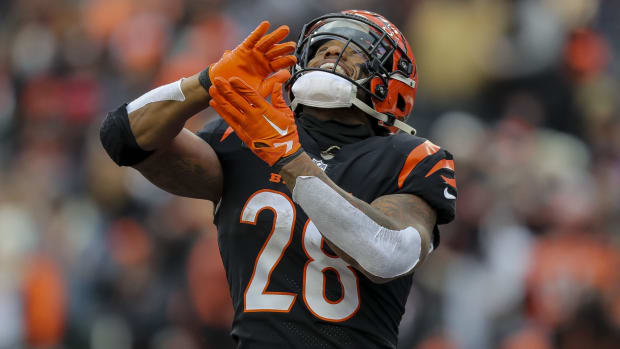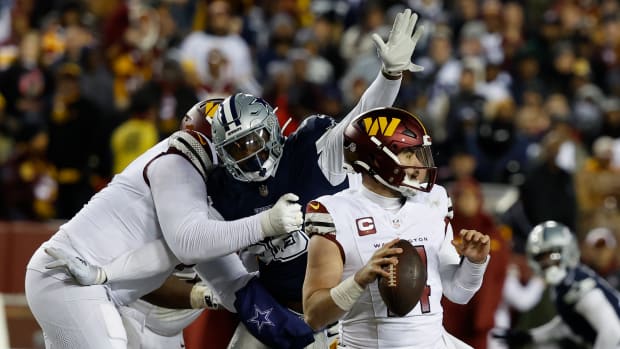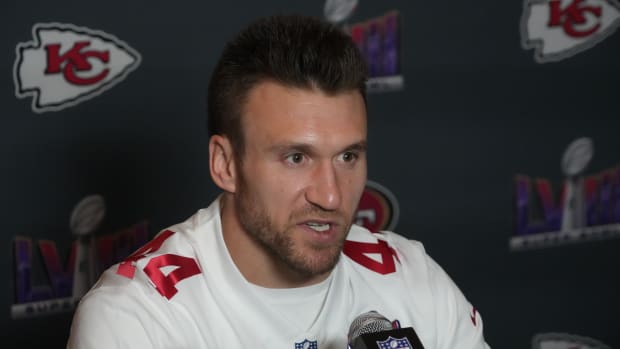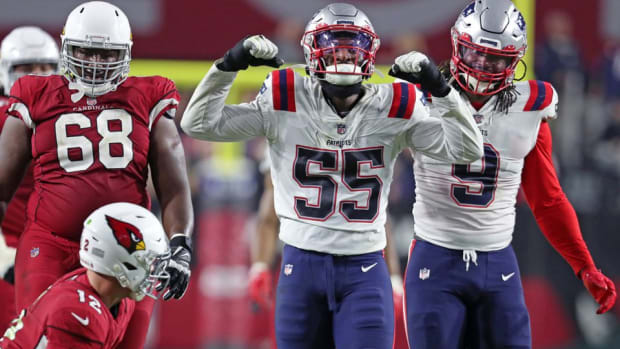Jaguars Preview: An Offensive Overhaul and a Sliver of Optimism
Rob Foldy/Getty Images
Throughout the preseason Andy Benoit will provide in-depth breakdowns of all 32 teams, in reverse order of 2013 finish. Today, the Jacksonville Jaguars …
OFFENSE
In just his second year on the job, Jaguars general manager Dave Caldwell might be coming off the best offseason in the NFL. He used the draft to address his team’s most dire needs, drafting for offense in the first round… and in the second… again in the second… and then in the third. Those four picks brought quarterback Blake Bortles, receivers Marqise Lee and Allen Robinson, and guard Brandon Linder.
A month earlier, Caldwell had used free agency to help revamp other parts of the offense, signing guard Zane Beadles to a five-year, $30 million deal and running back Toby Gerhart for three years and $10.5 million. Neither of those players will set the world on fire; Beadles was not highly regarded in Denver and Gerhart epitomizes average. But both will be meaningful contributors in a revamped ground game.
Caldwell’s overhaul was hardly making changes for the sake of change. The Jaguars’ offense ranked 32nd in points and 31st in yards and didn’t even look that competitive on film last season. This team simply could not move the football.
The Jaguars’ offense ranked 32nd in points and 31st in yards and didn’t even look that competitive on film last season. This team simply could not move the football.
The baseline problem was a weak interior O-line. Which isn’t to say that the edges of the offensive line weren’t problematic. Maybe it wouldn’t have mattered anyway, since none of Jacksonville’s receivers could shake man coverage. Of course, quarterbacks Blaine Gabbert (whom Caldwell dealt to San Francisco for a sixth-round pick) and Chad Henne struggled to read the field.
Henne will get another shot—at least early this season while Bortles develops. Bortles may not sit for long though. Head coach Gus Bradley was with the Seahawks in 2012, when rookie quarterback Russell Wilson unexpectedly proved ready for the starting job right away. Regardless of who is under center, Jacksonville’s offense will have nine different starters from last year’s Week 1 lineup. (This is counting last year’s second overall pick Luke Joeckel, who is switching from right tackle to left tackle and played only five games before suffering a broken ankle in 2013.) The only returning starters are wide receiver Cecil Shorts and fullback Will Ta’ufo’ou.
Making the transition from right tackle to left this season, Luke Joeckel (76) will essentially be a rookie again after playing just five games in 2013 before breaking an ankle. (John Raoux/AP)
What can we expect from this revamped group in offensive coordinator Jedd Fisch’s up-tempo system?
Let’s begin with Henne. The seventh-year pro is a capable pocket passer who has the willingness to stand tall and read the field under pressure. But a willingness to read the field and the aptitude for it are two different things. Henne throws too many interceptions, and a bulk of them come from misreads and poor decision-making. If that’s the case again this year, the Jags might as well start Bortles. Besides taking gobs of punishing sacks, the reason you let a rookie learn from the sideline is to avoid the exact kinds of mistakes that Henne is already prone to make. The Jags have nothing to lose.
Henne could benefit from the updated receiving corps, though it may take a full year or two for those updates to turn into upgrades. Early in his career at USC, Marqise Lee was projected by most to be a top-flight NFL receiver. Injuries and drops in production cooled his stock, but Lee has intriguing catch-and-run ability—something that Fisch’s scheme made great use of with Justin Blackmon last season. (Blackmon is suspended for yet another substance abuse violation and may never play in black and teal again.) Allen Robinson also brings good run-after-catch ability, only with more of a possession target focus to his game.
Fisch typically uses three wide receivers (he didn’t as often last year because of talent deficiencies and injuries). Fourth-year veteran Cecil Shorts is assured of a starting job, even though he doesn’t consistently separate from man coverage. Undrafted third-year pro Mike Brown, with his knack for locating the voids in zone coverage, might actually be the superior long-term prospect. Brown will likely get snaps ahead of fourth-round pick Ace Sanders, who came on toward the end of a disappointing rookie year.
Henne’s (or Bortles’s) best target this season may still be Marcedes Lewis, assuming the tight end is healthy after missing five games with a calf injury last year. His 6’6”, 275-pound frame alone makes Lewis a viable target in the seam. However, he’s never been a particularly steady receiver; solid in-line blocking has kept him in the lineup over his eight-year career.
Maurice Jones-Drew has long helped bolster Jacksonville’s passing attack, but after eight years that is no longer the case. Jones-Drew is now a Raider. Age is catching up to him, though he’s still more explosive at 29 than the 27-year-old Toby Gerhart. Think of any running back trait and the ex-Vikings backup is just so-so in it. Gerhart’s excited to be a workhorse, but don’t be surprised if he winds up sharing significant snaps with Jordan Todman, a middling backup—though one who can reach the perimeter.
As for the retooled offensive line, well, with just four complete games under his belt, the jury is still out on Joeckel. At center, Mike Brewster struggles on pulls and pile drives in the running game. Perhaps he’ll be sounder playing with better guards (Beadles on the left side and third-round rookie Brandon Linder on the right). According to scouts, Linder is an unimpressive athlete but touted phone booth blocker. That same description can apply to undrafted third-year right tackle Austin Pasztor, a converted guard who will need to be protected by the scheme.
Like most of this offensive lineup, Jacksonville’s front five is not scintillating, but it should be an upgrade over last year’s group.
Jaguars cornerback Dwayne Gratz breaks up a pass against the Bills last December. (John Raoux/AP)
DEFENSE
Gus Bradley is trying to turn this unit into the Seahawks of the Southeast. The former Seahawks defensive coordinator runs a zone-oriented scheme with a few more Cover 2 looks than the press Cover 3 ’Hawks. His man coverage concepts are limited mainly to third-and-short situations, which is also the only scenario in which he blitzes with any sort of regularity.
While things are schematically similar, Bradley doesn’t have the same caliber of personnel that he had in the Pacific Northwest. But not being on par with a Super Bowl-winning defense doesn’t mean his current group isn’t respectable. It’s much better than the club’s 4-12 record of a year ago suggests.
Let’s start with the secondary, the youngest and therefore most interesting of this defense’s three units. Playing a Seahawks-style scheme means having press corners outside. There’s a potentially effective one in Dwayne Gratz, a third-round pick and one of three rookies in the starting back four last season. At 5’11”, 200 pounds, Gratz lacks the size of Richard Sherman and his recovery speed has looked questionable at times. He’s solid outside but long-term might be best suited for the slot.
A young secondary can only be as good as its pass rush. Gus Bradley’s four-man rush in Seattle was formidable; his current one has been almost nonexistent.
If that’s the case, Bradley and defensive coordinator Bob Babich should play him there this season for developmental purposes. No. 3 corner Will Blackmon made some plays from the slot last season—most notably his game-sealing touchdown against the Titans in Week 10, when he blitzed and flat out took the ball from quarterback Ryan Fitzpatrick’s hands. But sturdy as Blackmon was, he’s a plug-in player rather than someone you build around. Ahead of Blackmon, the 6’2”, 195-pound Alan Ball has played with good physicality along the boundary and could figure into future plans, especially if Gratz moves to the slot.
The rest of the secondary’s youth resides at safety, where last year’s second-round pick Jonathan Cyprien and sixth-rounder Josh Evans both started as rookies. Their performances brought expected ups-and-downs and will do so again this season given their greenness in reading formations and route combinations. Both play with the requisite aggressiveness, which could help them break out once the light bulb goes on. Cyprien, having been drafted four rounds ahead of Evans, has the greater upside.
A young secondary can only be as good as its pass rush. This has been the biggest difference between the defense Bradley had in Seattle and the one he has here. His four-man rush in Seattle was formidable; his current one has been almost nonexistent. The addition of ex-Seahawk Chris Clemons will help change that, but only to an extent. The sinewy 32-year-old still bends the edge and closes quickly.
2014 Team Previews
Houston: O’Brien Builds Without a QB
Washington: Will a New Coach Mean a New and Improved RG3?
Cleveland: It All Rides on the Defense
The arrival of Clemons’s longtime Seahawks teammate Red Bryant won’t bolster the pass rush. But as a 6’4”, 320-pound run-stuffer, the $19 million free agent will be the front line’s only two-gap player, which is why he plays on the weak side. On the strong side you’ll find Tyson Alualu, a nickel defensive tackle who played inside fulltime upon entering the league as a first-round pick in 2010. Alualu’s second gear and combativeness in traffic are a plus, though he doesn’t have the sheer edge speed to always capitalize against one-on-one blocking. Unfortunately, neither does 2012 second-round pick Andre Branch, who lacks explosiveness.
Even with Clemons coming aboard, this defensive front still lacks pass-rushing firepower. It will, however, be difficult to run against. There’s girth and experience on the edges, plus two very good early down tackles in nose shade Roy Miller and three-technique Sen’Derrick Marks (the team’s most destructive force on a weekly basis last season). There’s also newfound rotational depth with ex-Steeler Ziggy Hood coming off the bench.
Linebacker Paul Posluszny will gobble up most of the tackles behind this front line. Posluszny plays with good speed and can consistently shed blocks. He has excellent chemistry with weakside backer Geno Hayes, another speedy read-and-pursue player. On the strong side, Dekoda Watson is the most experienced and will get a crack at starting, though a better option might be John Lotulelei, an undrafted second-year pro who was impressive with releasing double-teams via quick downhill attacks late last season.
SPECIAL TEAMS
Josh Scobee has been one of the game’s best kickers for years and is coming off a season in which he missed just two of his 25 field goal attempts. Bryan Anger will probably never live up to his third-round draft status (impossible for any punter to do, really), but he’s been solid, ranking seventh in net average last year. In the return game, Ace Sanders is expected to handle punts with Jordan Todman taking kickoffs.
BOTTOM LINE
This franchise still has a ways to go, but having hit Control-Alt-Delete on offense, there’s more room for optimism than there was at this time a year ago.









































